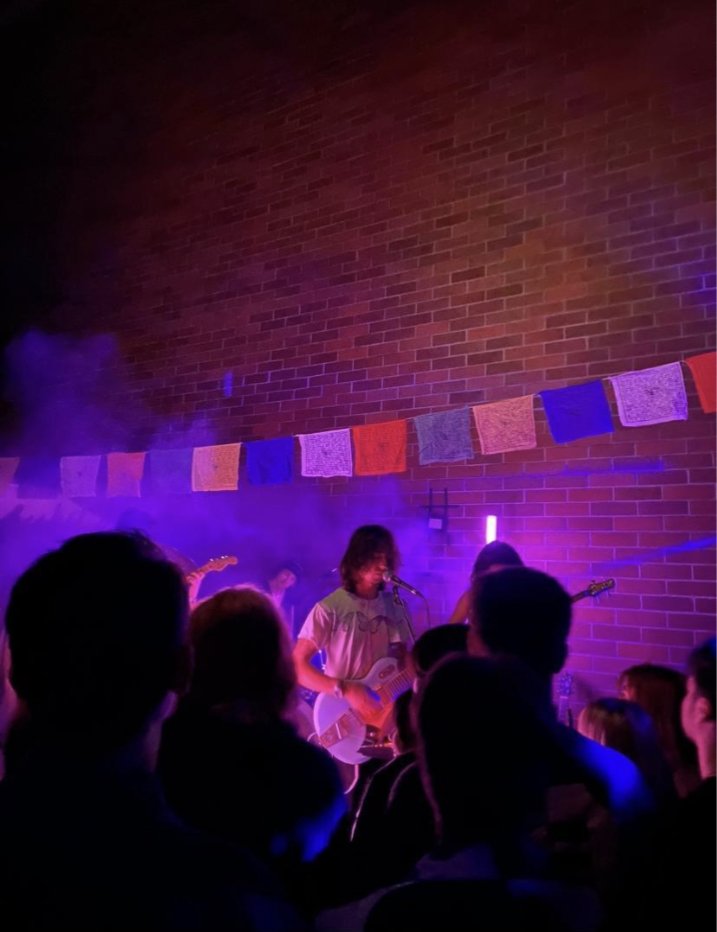The Issue of Inclusivity: North Seattle DIY Music Scene
The DIY music scene in North Seattle, despite being founded on socially conscious principles, still struggles with inclusivity. Even though social and political change is being evoked radically among people, the DIY scene as a whole fails to create an environment that is inclusive of people of color.
Photo of a local band playing at a D.I.Y. show in early October. This is typically what is seen on stage when attending shows in North Seattle. (Photo by Sophia Callan)
DIY, in the context of music, is related to the underground punk scene. The movement has been around worldwide for decades and was especially significant in Seattle during the height of grunge in the 90s. The movement is a way of taking a step from mainstream influences and providing a space for people who feel marginalized in society: women, people of color, and members of the LGBTQ community. It’s also a major resource for community-based creative work and political grassroots organizing. One example is the 1970s Rock Against Racism Movement (RAM), which originated in the UK as a way to target rising levels of racism in the music community. RAM worked to organize various gigs and worked with musicians to discourage young people from embracing racist values. With a constantly changing music industry and culture, questions may arise on whether or not people in the North Seattle scene are still educated on the DIY movement’s origins and values.
Colin, the Event Chair for WashPIRG at University of Washington, a chapter of the independent-citizen-funded Public Interest Research Groups (PIRG), focuses on solving special interest issues through grassroots work and organizing events with the DIY scene in North Seattle. WashPIRG has organized a few shows in North Seattle’s University District; a more recent show, coined the “Vampire Valentine’s,” was held in February. The show was organized as an effort to raise funding for the University of Washington’s Food Pantry.
““People in PIRGs are typically involved [in the scene],” mentioned Colin, “Most people in the scene are pretty conscious.””
However, despite its origins, inclusivity still seems to be an issue in the scene – nonwhite members seem to feel excluded. The North Seattle DIY scene is primarily located in the University District area surrounding the University of Washington, which as of fall 2022, has a white population of about 34.4%, according to the University of Washington Office of Minority Affairs & Diversity. Seattle as a whole has a white population of about 65.5%, according to the 2021 census. People of color have often felt uncomfortable at different shows in North Seattle. The lack of diversity often gives people a chance to not think critically about people of color’s presence.
When asked to comment, a former member of the scene in the 90s, who has decided to remain anonymous for privacy reasons, mentioned that historically, “Many people organizing shows are really just trying to promote local bands and maybe even make some extra cash,” and that the dominant population at these shows are “mostly white, so not a lot of people are thinking about inclusivity or safety for people of color.” So why the lack of nuance? Like our folks at WashPIRG, there are a lot of great things to take from the idea of incorporating music culture into an antiracist movement. But historically, and even today, there are tons of white artists and fans of Black music who still struggle to identify the contradiction of loving music from people of color and failing to uplift or ensure a safe space for them in the scene.
This isn’t necessarily representative of the entire Seattle music scene. The aforementioned source argued that the issue may lie mostly with the motives of the attendees, as many people in the area are university students looking for a party rather than music, and many students “aren’t educated on the movement’s origins.” On the contrary, they feel that groups in South Seattle have an older age demographic, people are often more established as artists in South Seattle, and are “more aligned with social justice and mutual aid work.” Many people in the University District simply “aren’t educated enough about the scene’s origins,” and it’s important to “highlight different aspects of the DIY scene.”
Even today the narrative surrounding the origins of Punk is typically centered around white, working-class men in the US and UK, bands like The Clash and The Ramones are typically held at the forefront, when in reality the Punk and DIY movement is also driven by several non-white and non-western acts, Death, Bad Brains, and a more contemporary Big Joanie are just a few examples of many artists. Ensuring that music is accessible and safe for people of color, especially in the DIY scene, is essential to not only encourage important dialogues surrounding diversity but to also continue to support and uplift more innovative music from an array of voices and backgrounds.
